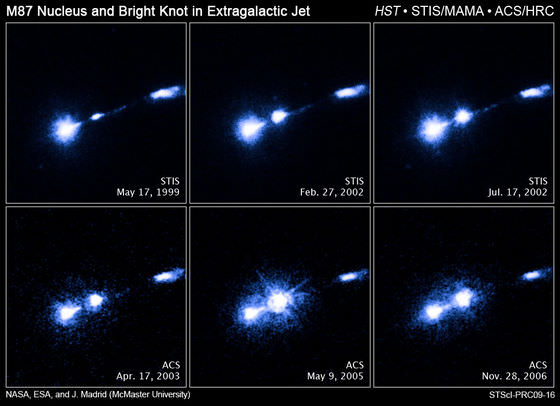

Hubble image of a gas jet blasing from the core of M87. Credit: NASA, ESA, and J. Madrid (McMaster University)
[/caption]
Our own Milky Way is classified as a spiral galaxy. But that’s just one of many classification of galaxies. One of the most common types are elliptical galaxies, named because they have an ellipsoidal (or egg) shape, and a smooth, almost featureless appearance.
Elliptical galaxies are usually large, containing hundreds of millions to trillions of stars. The biggest galaxies in the Universe are elliptical galaxies. They’re the result of many collisions between smaller galaxies, and all these collisions have destroyed the delicate spiral structure that we see in our own galaxy.
And they’re usually old. Elliptical galaxies look redder than spiral galaxies like the Milky Way. That’s because they contain old, red stars and have very low rates of star formation. All of the available gas and dust was already used up in the past, and now all that remains are these old red stars. They also have large populations of globular star clusters.
Elliptical galaxies are usually found in the most violent places in the Universe, like at the heart of galaxy clusters and in compact groups of galaxies. In these places, elliptical galaxies have had an accelerated life, with many galaxy mergers and several periods of star formation. These constant mergers and collisions increased their size and used up all the gas available for star formation.
The smallest dwarf elliptical galaxies are no larger than a globular cluster and can contain a mere 10 million stars. The largest elliptical galaxies can have well over 10 trillion stars. The largest known galaxy in the Universe, M87, is an elliptical galaxy.
We have written many articles about galaxies for Universe Today. Here’s an article about an ancient elliptical galaxy, and another elliptical galaxy where a black hole halted its formation.
If you’d like more info on galaxies, check out Hubblesite’s News Releases on Galaxies, and here’s NASA’s Science Page on Galaxies.
We have also recorded an episode of Astronomy Cast about galaxies – Episode 97: Galaxies.
How can we explore Saturn’s moon, Enceladus, to include its surface and subsurface ocean, with…
Have you ever wondered how astronomers manage to map out the Milky Way when it's…
NASA astronomers have been continuing to monitor the trajectory of asteroid 2024 YR4. The initial…
Some exoplanets have characteristics totally alien to our Solar System. Hot Jupiters are one such…
Stars form in Giant Molecular Clouds (GMCs), vast clouds of mostly hydrogen that can span…
Let’s dive into one of those cosmic curiosities that's bound to blow your mind: how…